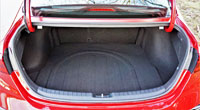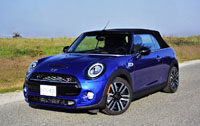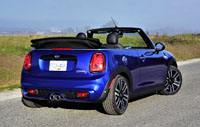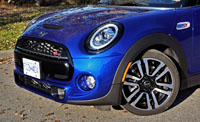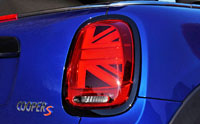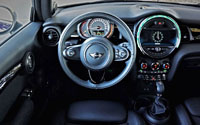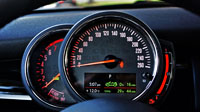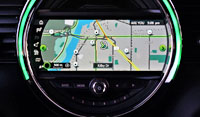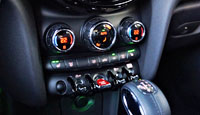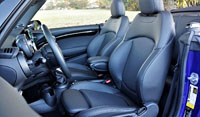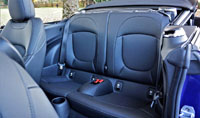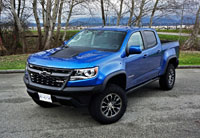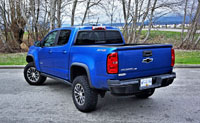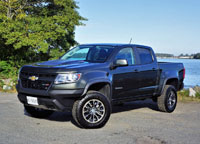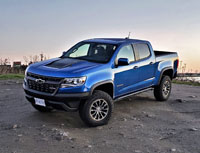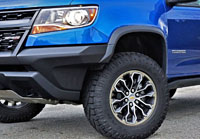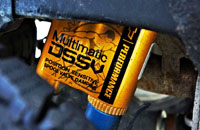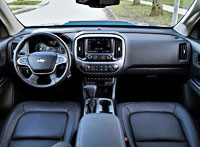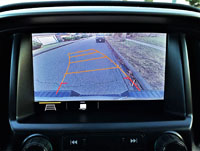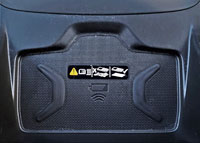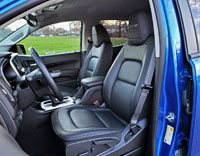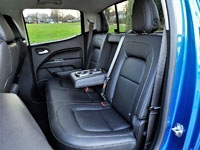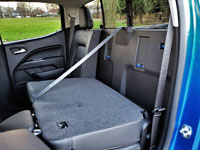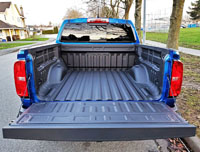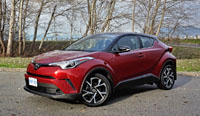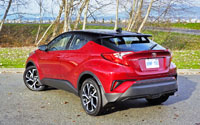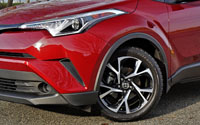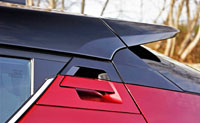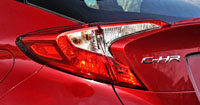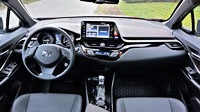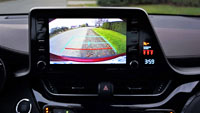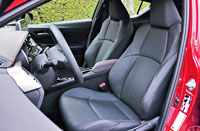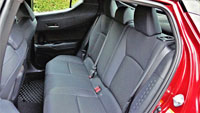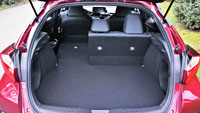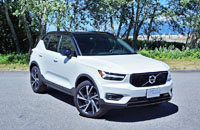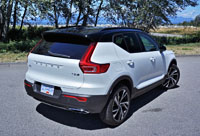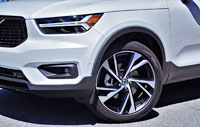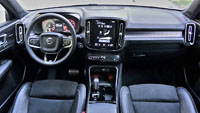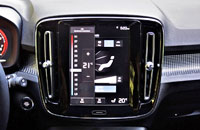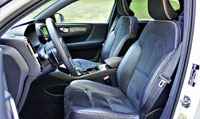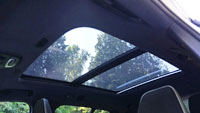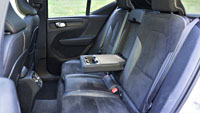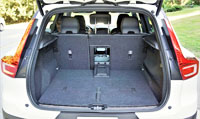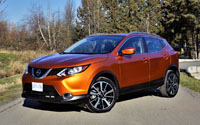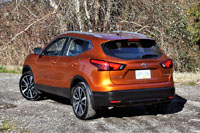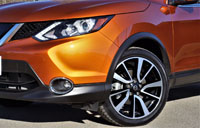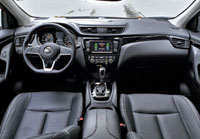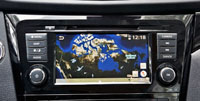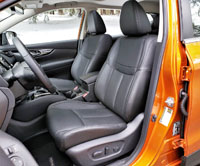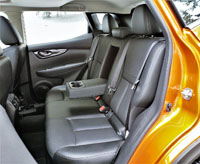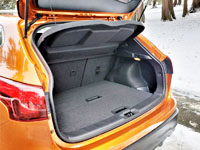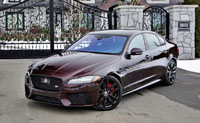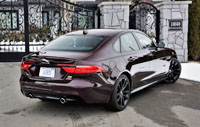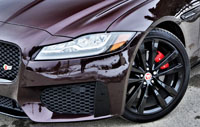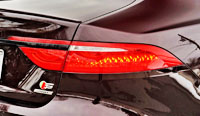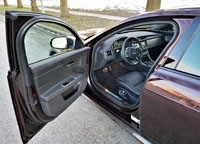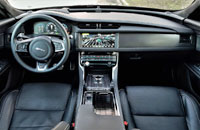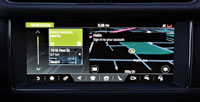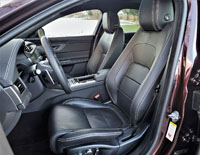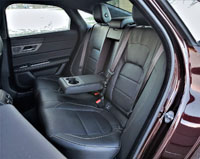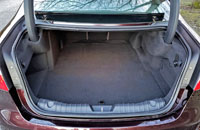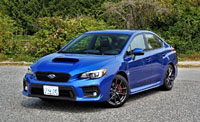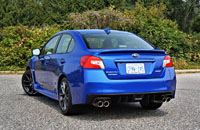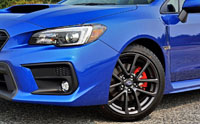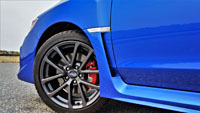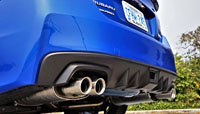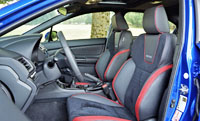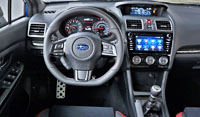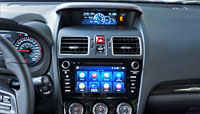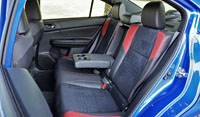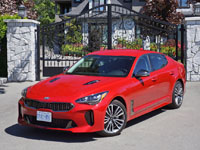
Finally! Every time I’ve been given the opportunity to test the new Kia Stinger something got in the way. The test model was either damaged by another journalist, or got put out to pasture before I could get into it, the latter due to me being out of country, but just a matter of days back from my regular winter warming in my favourite tropical isle had me ogling a beautiful California Red painted Stinger GT-Line parked in front of my temporary left coast home.
I have to say the Stinger looks impressively upscale. Even in my tester’s base GT-Line trim, it comes standard with automatic dual-function LED headlamps, LED daytime running lights, LED positioning lamps, body-wide bar-type LED tail lamps, classy dark chrome exterior trim details with the same darkened chrome used for the side mirror housings, these also enhanced with slim LED turn signals, while sharp looking 18-inch machine-finished alloy wheels on 225/45 rubber round out the look, as does a set of chromed exhaust pipes at back.
While base, it should be noted that the entry-level Stinger starts at a considerable $39,995 plus freight and fees, but despite its less than prestigious Kia branding it really comes across as something much closer to premium than most anything in its mid-size segment.
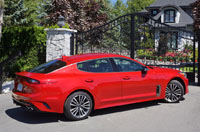
The Stinger is a mid-size sedan, by the way. I’ve noticed some consider it compact because it utilizes the same underpinnings as the Genesis G70, which is a compact luxury model going up against BMW’s 3 Series, Mercedes’ C-Class, Audi’s A4, et al, but in spite of having similar wheelbase lengths of 2,910 mm (114.4 in) compared to 2,835 mm (111.6 in), both being longer than the Optima’s 2,805-mm (110.4-in) wheelbase, the Stinger’s 4,830 mm (190.2 in) nose-to-tail length spans 145 mm (5.7 in) farther than the G70’s, while it only measures 20 mm (0.8 in) shorter than Kia’s Optima family sedan.
Also notable, at 1,870 mm (73.6 in) the Stinger is 20 mm (0.8 in) wider than the G70 and 10 mm (0.4 in) narrower than the Optima, while it stands 1,400 mm (55.1 in) tall, which is identical to the G70 and 70 mm (2.7 in) lower than the Optima. Those still choosing to call the Stinger compact will also want to take note that it’s 190 mm (7.5 in) longer than the Forte sedan (a reasonable large compact itself), with a 210-mm (8.2-in) longer wheelbase, while it’s 70 mm (2.7 in) wider too. So it’s obviously a mid-size model, even offering up a longer wheelbase and more width than the Toyota Camry and Honda Accord, although slightly less length and height.
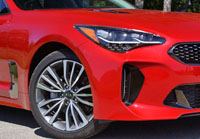
The Stinger’s long, low and wide dimensions make it more of a four-door coupe-like sedan, its sporty profile backed up by dynamic styling and a premium cabin, at least for its volume branded pedigree (or lack thereof). I should mention this isn’t Kia’s first premium-like entry, or for that matter its most luxurious. We only need to look to the Mercedes S-Class/BMW 7 Series-sized K900 for Kia’s highest-end car, a model that might only be outmaneuvered amongst pedestrian brands for all out premium cachet by the Volkswagen Phaeton, but like that outrageous VW the K900 didn’t garner enough popularity to enjoy prolonged availability in Canada, so therefore is now history north of the 49th.
Where the K900 was a seriously impressive luxury sedan, it couldn’t even come close to the Stinger’s viability here in Canada. It comes down to affordability, its more popular mid-size market segment, and a greater focus on performance than luxury. Size aside, I would’ve previously said it comes closest to mirroring the Dodge Charger in spirit than anything else in its class, at least until Volkswagen showed up with its new Arteon a few months ago. The Arteon, that’s based on the European Passat, just replaced the outgoing CC four-door coupe. The two are near identical in size and similarly powered, so are therefore going after the same sport-oriented customers, in the Stinger’s base trim at least, but with its base price more than $8,000 loftier than the Stinger’s aforementioned window sticker, the new Arteon is reaching up much further into premium territory.
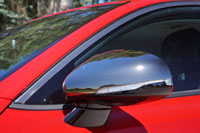
By the way, the Stinger weighs in between 1,729 and 1,782 kilograms (3,812 and 3,929 lbs) with its as-tested 2.0-litre turbocharged four-cylinder, or 1,873 and 1,889 kg (4,129 and 4,165 lbs) with its optional V6, whereas the Arteon hits the scale at 1,748 kilos (3,854 lbs) and the larger and heftier Charger offers more mass for your dollars at 1,823 to 1,980 kg (4,021 to 4,530 lbs). While lighter than the Charger, the all-wheel drive Stinger and Arteon are significantly heavier than the previously noted mid-size front-drive family sedans, giving the car being reviewed here, at least (I’ve yet to drive the Arteon that’s scheduled for August 26), more of a substantive, premium-like feel.
Kia really does manage to pull off a near luxury brand level of refinement inside thanks to details like cloth-wrapped A, B and C pillars, a soft, pliable dash top with a really well-finished padded instrument bolster crossing the entire dash front, as well as premium-level soft composite door uppers front to back. All of the Stinger’s button, knobs and switches are nicely fitted with good damping as well, with some aluminized for an especially upscale look and feel, while this base model’s standard perforated leather upholstery is definitely up to par for a volume-branded sedan.
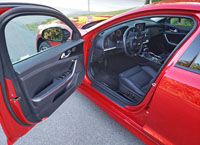
Being that we’re already talking about features, standard content includes a heated leather-clad flat-bottom sport steering wheel that’s sized perfectly for performance and feels great in the hands, plus a leather-wrapped and chrome-adorned shift knob, piano black interior accents, comfortable and supportive heatable eight-way powered front seats with four-way power-adjustable lumbar, an auto-dimming rearview mirror, power-folding outside mirrors, two-zone auto HVAC, LED cabin lighting, ambient mood lights, and a 7.0-inch infotainment touchscreen that’s my only cause for complaint, being that it’s too small and isn’t flush within its fixed mounting and therefore looks dated.
This display houses the usual backup camera, plus Apple CarPlay and Android Auto smartphone integration, and Kia’s exclusive UVO Intelligence connected car services, while nine-speaker audio provides good sound quality for a base stereo, even incorporating standard satellite radio, whereas the wireless device charger is a very impressive standard feature as well.
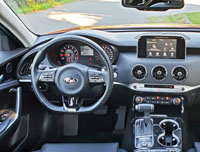
Proximity-sensing technology lets you in the car while a satin-silver button fires up the engine, again on the standard menu, while the electric parking brake releases automatically. The just noted rearview camera combines with standard rear parking sonar and rear cross-traffic alert to help keep the Stinger’s dazzling paintwork free from scratches and dents, the latter feature bundled together with blind spot detection. Once pointing forward choose from a list of Drive Mode Select settings including Smart, Eco, Comfort, Sport and Custom, slot the eight-speed Sportmatic automatic gearbox in Drive or move the lever over to manual mode in order to get the most out of the standard steering wheel paddle shifters, which is how I enjoyed all 255 horsepower and 260 lb-ft of torque generated by the Stinger’s standard direct-injection, turbocharged, 2.0-litre four-cylinder engine.
This might only be the base powertrain, but due to 100 percent of its torque arriving at only 1,400 rpm, plus each of its four wheels simultaneously gripping the pavement below, this most basic of Stingers moves away from a standing start quickly, and stays on the power to highway speeds and beyond. Its twin exhaust pipes make a nice sporty note, complementing the engine’s mechanical tone, the Stinger delivering an enjoyable soundtrack alongside its strong acceleration.
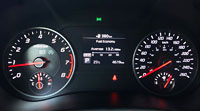
Of course, this base engine won’t be as brilliantly satisfying as the available twin-turbocharged 3.3-litre V6, that powerhouse providing 365 soul-stirring horsepower and 376 lb-ft of twist (the Arteon doesn’t offer an optional powertrain), but the turbocharged four is a compromise I’d be more than happy to live with, particularly when factoring in its much greater efficiency. Comparatively, the four-cylinder is rated at 11.1 L/100km city, 8.1 highway and 9.7 combined, whereas the V6 gets a claimed 13.6, 9.6 and 11.8 respectively, while both are assisted by an auto start/stop system that shuts the engine off when it would otherwise be idling.
I’m guessing the last thing you’ll want to be thinking about when flinging the Stinger through a set of fast-paced curves is fuel economy, the car’s fully independent MacPherson strut front and multi-link rear suspension featuring gas shocks and dynamic dampers that help to deliver an ideally firm yet compliant ride and handling combination that proves superb over all types of tarmac, from broken backroads to smooth-as-glass freeways.
Braking is also strong, with four-cylinder models benefiting from 320 mm (12.6 in) front vented discs and 314 mm (12.4 in) rear solid rotors, plus the V6 model improving binding power with a set of Brembo discs measuring 350 mm (13.8 in) and 340 mm (13.4 in) respectively, plus the addition of vented rotors in the rear.
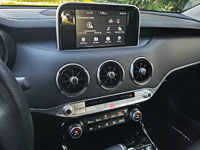
While the Stinger looks fast standing still, its long and lean body capable of minimizing drag and amply maximizing downforce, it also provides more than enough rear headroom for most adults’ needs. I had about three inches above my five-foot-eight frame when seated behind the driver’s seat, so six-footers should have no problem. What’s more, cargo access is excellent due to its less conventional four-door coupe-style rear liftback, which opens up to 660 litres (23.3 cu ft) of volume behind the 60/40-split rear seatbacks or 1,158 litres (40.9 cu ft) of gear-toting space when they’re flipped forward. So the Stinger is not only good looking, fun to drive and beautifully finished inside, it’s also plenty practical.
I’ll be spending a week with the new Arteon soon, and will let you know if it measures up to the Stinger for passenger and luggage space, plus if its loftier price range provides any benefits, but I’ll say right now the VeeDub will need to be very good in order to upstage this Stinger when it comes to performance, interior quality, features and value. As it stands, with all options included the Arteon costs just over $53k, which makes it pricier than the most expensive $51,495 Stinger GT Limited 20th Anniversary Edition that gets unique 19-inch alloys, carbon fibre décor trim, red Nappa leather, and custom red-stitched “Stinger” floor mats, while the mid-range Stinger GT starts at $44,995 and the regular GT Limited can be had for $49,995 (learn more about 2019 Kia Stinger trims, packages and standalone options right here at CarCostCanada, and don’t forget that we can help you save hundreds or even thousands via manufacturer rebates and dealer invoice pricing).
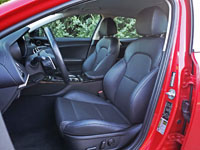
The last two trim lines get there own set of 19-inch alloys, an upgraded suspension with Dynamic Stability Damping Control (DSDC), noise-reducing front side glass, auto-dimming outer mirrors, stainless steel tread plates, stainless sport pedals, carbon fibre-style inlays (that replace the piano black ones), shift-by-wire transmission control (replacing the base model’s shift-by-cable gearbox) a power-adjustable tilt and telescopic steering wheel, driver’s memory, an under-floor storage tray, a large moonroof, a gesture-controlled power liftgate, plus a luggage net.
Finally, the GT Limited provides a special set of cornering headlights, rain-sensing windshield wipers, aluminum-finish trim (replacing the faux carbon fibre), a black roofliner, a 7.0-inch Supervision LCD/TFT digital instrument cluster, a heads-up display (HUD), a HomeLink universal transceiver, Nappa leather upholstery, cooled front seats, heated rear outboard seats, a driver’s seat upgrade with four-way “air cell” lumbar support, powered side bolsters, and a power-operated lower squab extension, an 8.0-inch infotainment touchscreen (that really should be standard) with a surround parking monitor system and navigation, 15-speaker Harman Kardon audio, dynamic cruise control, autonomous emergency braking (that’s usually standard in this class), lane keep assist, and driver attention alert.
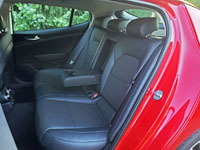
You might be interested in knowing that year-over-year (YoY) Stinger sales slipped a bit during the first six months of this year in Canada, having dropped 14.38 percent due to just 750 units leaving Kia dealer lots, but this said it’s doing its job to boost the brand’s mid-size car sales now that the Optima has become 44.67 percent less popular over the same half year, with just 872 deliveries on the books. As for how the Stinger sells against regular front-drive mid-size sedans, the Camry took no prisoners over the same two quarters with 8,586 sales (an increase of 12.87 percent), whereas the Accord held second with 5,837 deliveries (dropping 9.71 percent). The Arteon, incidentally, found just 184 buyers so far in 2019, but to be fair it only came on the market this spring so we’ll need to wait and see how it fares over the long haul. This said if the Passat is any indicator, its poor Q1 and Q2 total of 474 deliveries should hardly give VW confidence, this number representing a 75.55 percent fall from grace compared to January through June of 2018.
Continuing on this theme, there are 14 different mid-size sedans fighting it out in this class, including the Stinger and Arteon, but not the aforementioned Charger that competes against cars like the Toyota Avalon, Nissan Maxima etcetera in the full-size or large sedan category. Of these 14, nine are in the red as far as growth goes, one (the Arteon) is to new to measure, and just four are in the black (positive), while the Stinger’s small decline is not as significant as many rivals, and more the result of the entire mid-size sedan category’s loss of favour than any lack of interest in this specific car.
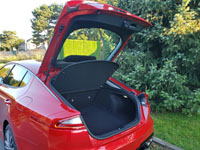
In fact, I witness the polar opposite during my entire test week, with loads of smiling stares, positive nods of appreciation and general goodwill while driving by onlookers. Stinger owners can hold their heads high as this car garners a lot of respect, while it will no doubt benefit Kia’s overall brand image long-term as well. If you’re thinking about purchasing a new mid-size sedan, you may want to take a closer look at this innovative, well-sorted four-door coupe, because it delivers a higher level of style, refinement and features than most rivals, while it still should be practical enough for most peoples’ requirements.
Story and photo credits: Trevor Hofmann

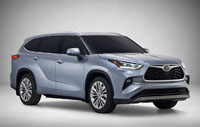
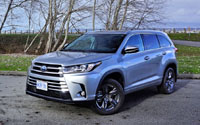
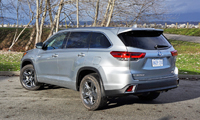
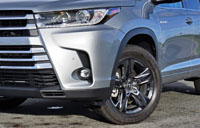
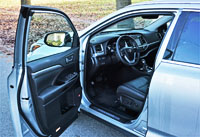
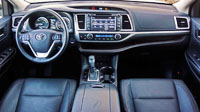

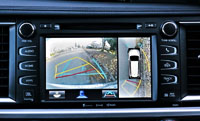
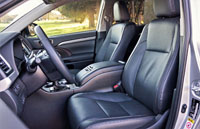
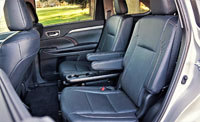
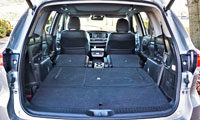
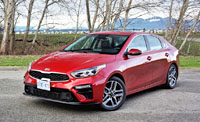
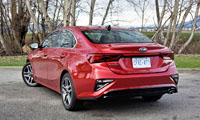
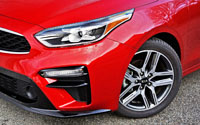
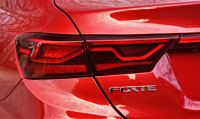
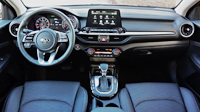

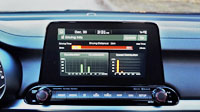
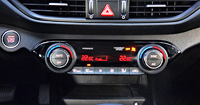
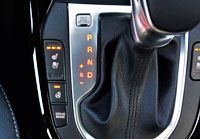
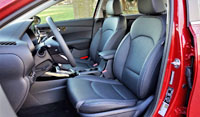
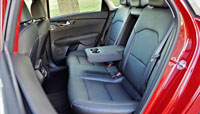 After setting up the driver’s seat for my body type, I sat directly behind in order to test rear seat roominess. The result was loads of space for my feet, plus about five inches in front of my knees, another three and a half or so over my head, about five beside my outer shoulder, and four next to my hip. In other words, the Forte provides a lot of room for rear passengers, and plenty of comfort too.
After setting up the driver’s seat for my body type, I sat directly behind in order to test rear seat roominess. The result was loads of space for my feet, plus about five inches in front of my knees, another three and a half or so over my head, about five beside my outer shoulder, and four next to my hip. In other words, the Forte provides a lot of room for rear passengers, and plenty of comfort too.